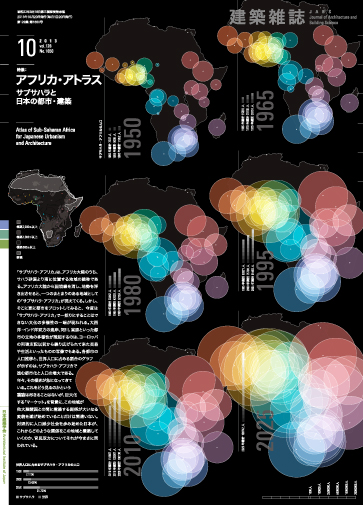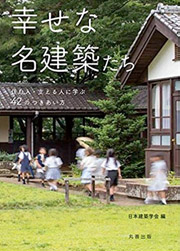本文PDFの閲覧につきましては、こちらでご確認ください。

2013-10月号 OCTOBER
特集= アフリカ・アトラス
─サブサハラと日本の都市・建築
Atlas of Sub-Saharan Africa for Japanese Urbanism and Architecture
特集前言 建築・都市の視点からサブサハラの地図を描く
ギリシア神話に登場する神アトラスは、両腕と頭で天の蒼穹を支える。メルカトルが世界各地の地図を編纂するという大事業の完成を見ずに没した後、1595年に出版された地図集は、彼の遺志に基づきアトラスと名付けられ、表紙には巨神アトラスが描かれた。生前のメルカトルの手元には、まだアフリカの地図は揃っていなかった。
私たちにとっても、建築・都市の視点から見たアフリカの地図をはっきり想像することはまだ難しい。広い意味での地中海世界に属す北アフリカはイメージしやすいが、サハラ以南のいわゆる「サブサハラ」の像は空白に近いからだ。このサブサハラこそ、グローバル経済下の資源・エネルギー開発競争の激化のなかで、世界的な注目を集めつつある地域である。しかし、これまでの長い経済的停滞から急激に進む経済成長と人口増加は、「開発なき成長」とそれに伴う歪な都市化という問題をはらんでいる。
世界の注目がアフリカに集まるなか、わが国も対アフリカODA総額をこの5年で倍増させている。今年6月には第5回アフリカ開発会議(TICAD V)を開催し、さらなる関係強化を確認したところである。
本特集では、そうしたアフリカをめぐる近年の状況を背景として、アフリカのアトラスをつくりつつ、日本との関係やその将来を議論する足がかりとしたい。
巻頭インタビューでは、ブルキナファソ等の西アフリカに居住するモシ族の無文字社会の文化と歴史の研究はもちろん、レヴィ=ストロースの『悲しき熱帯』の訳者としても知られる文化人類学者の川田順造氏に、サブサハラの歴史文化的な特徴について、住居も含む幅広い視野から示唆に富むお話をいただいた。
第1部「今のアフリカを知る」は、志摩憲寿・岡崎瑠美・清水信宏の各氏による「アフリカルテ」で始まる。すでに東大GCOEの発行する季刊『cSUR』の企画として進行している内容の一部を本誌向けに再編集したものであり、アフリカ全体の地誌的特徴に加え、主要都市の構造をマップ化している。
続いて林玲子氏にはアフリカの人口増加予測と都市化の意義について、また、平野克己氏にはアフリカの経済成長をグローバリゼーションの世界史的展開の表象として解説いただいた。さらに志摩憲寿氏に、主要海外援助機関による都市・建築にかかわる援助戦略の構造を説明していただいた。
第2部「アフリカと日本の都市・建築との交わり」では、まず、原広司研究室が行った西アフリカ集落調査(1978-79)について山中知彦氏に、丹下健三によるナイジェリアのアブジェ新首都計画(1981-89)について古市徹雄氏に、それぞれ回想いただいた。続いて、坂田泉氏にはケニアにおける建築教育とそこから展開した進行形のプロジェクト、三宅理一氏にはエチオピアでのキリスト教会堂の保護・活用への協力、さらに田中幸成氏にアフリカの都市計画・都市開発へのJICA支援、設楽知弘氏にODAプロジェクトとしての小中学校建設の現状を紹介いただいている。最後に、建築分野でのアフリカ研究の系譜と現在に関するレファレンスを岡崎瑠美氏にまとめていただいた。
第3部は、都市・建築分野での今後の日本とアフリカのかかわりについて展望する座談会とした。マリ共和国出身で建築計画を専門とするウスビ・サコ氏、コンゴでの小学校建設と教育のプログラムを進めている松原弘典氏、開発援助コンサルタントであり経済・政策から都市計画まで広く通暁する山形浩生の3氏によって、グローバルな見取図とアクチュアルな現場とを往還しながら、刺激的な議論が展開されている。
なお、松原氏が紹介するコンゴのプロジェクトについて、映画監督の落合賢氏による写真を掲載した。現地の若者と日本人学生たちとの協働の風景は、アフリカと日本のこれからを示唆している。また、本号の特集テーマをより深く理解するためのブックガイドを清水信宏氏に作成していただき、特集の最後に掲載した。
特集全体を通して、サブサハラ地域の開発をめぐる現状と諸課題だけでなく、同時に、日本の「建築」の、その軌跡に根ざした課題と可能性とが批判的に照らし出されていることに注意して読んでいただければ幸いである。
※本号特集の編集に当たっては、志摩憲寿(東京大学)、岡崎瑠美(フランス国立科学研究センター)、清水信宏(慶應義塾大学)の3氏に全面的に協力いただいた。記して感謝したい。
会誌編集委員会
本号編集担当:中島直人(慶應義塾大学)
[目次]
| 000 | 連載 再建への意志:図面のなかの都市復興 パレスチナ自治区における都市計画/横田雅幸 |
| 002 | 連載 東日本大震災|連続ルポ1|動き出す被災地 通い漁業のゆくえ─石巻市河北町長面浦の漁業復興を目指して/竹内昌義 |
| 004 | 連載 東日本大震災|連続ルポ2|仮すまいの姿 震災復興のまちづくり─「ハネウェル居場所ハウス」(大船渡市末崎町)での取組み/熊谷君子 |
特集 アフリカ・アトラス─サブサハラと日本の都市・建築
| 006 | 特集前言 建築・都市の視点からサブサハラの地図を描く |
| 008 | インタビュー アフリカの歴史と文化・風土、そして日本/川田順造 |
第1部 今のアフリカを知る
| 014 | アフリカルテ─サブサハラ・アフリカを読み解く一助として/志摩憲寿 + 岡崎瑠美 + 清水信宏 |
| 020 | アフリカの人口と都市化の未来像/林玲子 |
| 022 | アフリカの経済成長を世界史的展開としてとらえる/平野克己 |
| 024 | サブサハラ・アフリカ都市をめぐる主要ドナーの援助戦略/志摩憲寿 |
第2部 アフリカと日本の都市・建築との交わり
| 026 | 回想 東京大学生産技術研究所 原研究室・西アフリカ集落調査(1978-1979)/山中知彦 |
| 027 | ナイジェリア・新首都アブジャ計画/古市徹雄 |
| 028 | 虹を架ける仕事─ケニアにおける建築教育の経験を通じて/坂田泉 |
| 029 | エチオピアにおけるキリスト教会堂の保護/三宅理一 |
| 030 | アフリカの都市におけるJICAの取組み/田中幸成 |
| 032 | ODAプロジェクトとしてのアフリカにおける小・中学校建設の設計・監理の課題と可能性/設楽知弘 |
| 034 | 日本におけるサブサハラ地域の都市・建築研究/岡崎瑠美 |
第3部 これからのアフリカと日本の都市・建築
| 036 | 築き上げるのは笑う門─コンゴ・アカデックス小学校建設プロジェクトの風景/落合賢 |
| 038 | 座談会 これからのアフリカと日本の都市・建築/ウスビ・サコ × 松原弘典 × 山形浩生 |
| 043 | ブックガイド:「これからのアフリカ」の都市・建築を考えるための10 冊/清水信宏 |
| 045 | 編集後記 中島直人 |
| 045 | 次号予告 2013年11月号|特集:「建築家」が問われるとき―自己規定の軌跡と現在 |
| 046 | 特集を読んで 2013年8月号|特集:アジアン・ハウジング・ナウ 息づく伝統と高速変化/平山洋介 現代グローバル社会とアジアン・ハウジングの狭間で/福島茂 |
| 047 | 連載 建築の争点 相次いで公表される最大級地震の強震動にどう向き合えばよいか/久田嘉章 |
| 048 | 連載 ケンチク脳の育て方 阪神・淡路大震災後の復興教育/舩木伸江 + 石川永子 |
| 049 | 連載 ケンチク脳の活かし方 ペーパースカルプチャー─立体作品の独創的な世界/安座上真紀子 |
| 050 | 連載 地域いろいろ・多様な日本 学生の力をまちづくりに─「ワテラス」を拠点とした淡路エリアマネジメントの取組み/松本久美 |
Preface to the Special Issue: Drawing Sub-Saharan Maps in the Light of Architecture and Urbanism
The Greek mythological god Atlas holds the vault of heaven on his shoulders. And after Mercator died without seeing completion of his great project to edit maps from all over the world, based on his dying wish the map collection published in 1595 was named Atlas and the great god Atlas was drawn on the cover. But Mercator in his lifetime never got his hands on the complete maps of Africa.
And it is still difficult for us also to clearly imagine African maps from the viewpoint of architecture and urbanism. For although it's easy to imagine a North Africa that belongs to the Mediterranean world in the wide sense, the image of a so-called sub- Saharan area south of the Sahara is almost blank. Yet this sub-Saharan Africa is the very area now attracting worldwide attention in the global economy's intensifying scramble for resources and energy development. And in light of long prior economic stagnation, the mushrooming economic growth and population increases carry problems such as growth without development and, concomitantly, distorted urbanization.
And while worldwide attention has focused on Africa, Japan in the past five years has doubled its total ODA to Africa. Japan held TICAD V in June 2013 and confirmed the further intensification of relations.
In this feature, by drawing maps of Africa against the background of such recent African circumstances, we want to establish a toehold for argument about Africa-Japan relations and their future.
In the opening interview, Junzo Kawada, a cultural anthropologist well known of course for his study of the culture and history of the Mossi's non-literate society in West African areas such as Burkina Faso, and also as a translator of Levi-Strauss's Tristes tropiques, gives a highly suggestive talk about sub-Saharan historic-cultural traits from a broad view that includes dwellings.
Part 1, "Knowing Africa Today," begins with "AFRICARTE" by Norihisa Shima, Rumi Okazaki, and Nobuhiro Shimizu. Reedited for JABS, it is part of a booklet, whose plan the University of Tokyo GCOE's CSUR has already been advancing, and includes all African topographic characteristics and additionally maps the structures of the main cities.
Following that, Reiko Hayashi explains estimated population increases and the meaning of urbanization in Africa, and Katsumi Hirano explains Africa's economic growth as a sign of globalization's world-historic development. Further, Norihisa Shima interprets the structure of support strategies concerning urbanism and architecture by the main foreign support organizations.
In part 2, "Exchanges between Africa and Japanese Urbanism and Architecture," first, Tomohiko Yamanaka reminisces about the Hiroshi Hara Laboratory's research on West African villages (1978-79), and Tetsuo Furuichi about Kenzo Tange's plan for the new capital in Abuja, Nigeria (1981-89). Next, Izumi Sakata reports on architectural education and consequent ongoing projects in Kenya, Riichi Miyake on cooperation for the use and protection of Christian churches in Ethiopia, Yukinari Tanaka on JICA's support of urban planning and urban development in Africa, and Tomohiro Shitara on the state of elementary and junior high school construction as ODA projects. At the end, Rumi Okazaki organizes a reference of past and present African studies in the field of architecture.
Part 3 is a round table to view relations hereafter between Japan and Africa in the fields of urbanism and architecture. Oussouby Sacko, from the Republic of Mali, a specialist in architectural planning and design, Hironori Matsubara, who is advancing elementary school construction and educational programs in Congo, and Hiroo Yamagata, a development-assistance consultant whose deep acquaintance runs from economics and policy to urban planning, together roll out an exciting argument that shuttles between global sketches and actual scenes. In addition, appear photos by movie director Ken Ochiai concerning the Congo project that Matsubara introduces. The scenes of local youths and Japanese students working together suggest the future of Africa and Japan. Furthermore, a book guide to expand readers' understanding of the issue is created by Nobuhiro Shimizu.
Throughout the feature, we will be happy if you read heeding not only the current state and various issues surrounding sub- Saharan development but also at the same time the critically illuminated issues and possibilities arising from the tracks of Japanese architecture.
Norihisa Shima (The University of Tokyo), Rumi Okazaki (Centre National de la Recherche Scientifique), and Nobuhiro Shimizu (Keio University) wholly cooperated in editing this feature. We express our appreciation.
Editorial Board
This issue has been edited by Naoto Nakajima (Keio University).
[Contents]
| 000 | [Series] The Resolve to Rebuilding: City Reconstruction in Blueprint Urban Planning in the Occupied Palestinian Territory / Masayuki Yokota |
| 002 | [Series] Great East Japan Earthquake Serial Report 1 Devastated Areas Have Just Started to Stir Commuter/On-site, the Whereabouts of a Fishery─Aiming to Revive the Fishery with Manifold Resources at Nagatsura-ura, Kahoku-cho, Ishinomaki / Masayoshi Takeuchi |
| 004 | [Series] Great East Japan Earthquake Serial Report 2 Life in Temporary Housing Town Improvement in Earthquake Recovery─The Effort at Honeywell Ibasho House in Massaki-cho, Ofunato / Kimiko Kumagai |
Special Feature
Atlas of Sub-Saharan Africa for Japanese Urbanism and Architecture
| 006 | [Preface to the Special Issue] Drawing Sub-Saharan Maps in the Light of Architecture and Urbanism |
| 008 | [Interview] African History, Culture, and Natural Features, Then Japan / Junzo Kawada |
Part1 Knowing Africa Today
| 014 | AFRICARTE─Understanding Sub-Saharan Africa / Norihisa Shima + Rumi Okazaki + Nobuhiro Shimizu |
| 020 | African Population Growth and Urbanization─The Future / Reiko Hayashi |
| 022 | Africa' s Economic Growth As a Part of the Global History / Katsumi Hirano |
| 024 | Major Donors' Urban Development Strategies to Sub-Saharan Cities / Norihisa Shima |
Part2 Exchanges between Africa and Japanese Urbanism and Architecture
| 026 | Recollections of the Hara Laboratory's Research on West African Villages (1978-1979) / Tomohiko Yamanaka |
| 027 | New Capital City Abuja, Nigeria / Tetsuo Furuichi |
| 028 | Building a Rainbow between Kenya and Japan─Through an experience of Architectural Education in Kenya / Izumi Sakata |
| 029 | Conservation of Orthodox Monasteries and Churches in Ethiopia / Riichi Miyake |
| 030 | JICA' s Approach and Activities Toward Cities in Africa / Yukinari Tanaka |
| 032 | Design and Supervision for School Construction of Primary and Secondary Schools in ODA Project in Africa: Problem and Possibility / Tomohiro Shitara |
| 034 | Urban and Architectural Studies on Sub-Saharan Africa in Japan / Rumi Okazaki |
Part3 Africa Hereafter and Japanese Urbanism and Architecture
| 036 | Building a Gate to Happiness Scenes of the ACADEX Primary School Project in Congo / Ken Ochiai |
| 038 | [Discussion] Africa Hereafter and Japanese Urbanism and Architecture / Oussouby Sacko × Hironori Matsubara × Hiroo Yamagata |
| 043 | Book Guide: Ten Books for Thinking About Urbanism and Architecture in "Future Africa" / Nobuhiro Shimizu |
| 045 | [Editor's Postscripts] Naoto Nakajima |
| 045 | [Previews of Coming Issues] 2013, November|When "Architect" Is Called into Question─Past and Present Self-Definitions |
| 046 | [Reviews of Previous Issue] 2013, August|Asian Housing Now Traditional approaches and high-speed transformations / Yosuke Hirayama Contemporary Global Society and Asian Housing / Shigeru Fukushima |
| 047 | [Series] Issues in Architecture How Should the Architectural Engineers Cope With the Strong Ground Motions of the Worst Case Scenario Earthquakes? / Yoshiaki Hisada |
| 048 | [Series] Cultivating Versatile Architects Education in Kobe After the Great Hanshin-Awaji Earthquake / Nobue Funaki + Eiko Ishikawa |
| 049 | [Series] Architects Branch Out Paper Sculpture─The Original World of Three-Dimensional Works / Makiko Azakami |
| 050 | [Series] Local Identities: Diverse Japan Town Development Encouraged by Student Power─Awaji Area Management Association Based in WATERRAS Building / Kumi Matsumoto |




 『幸せな名建築たち 住む人・支える人に学ぶ42のつきあい方』
『幸せな名建築たち 住む人・支える人に学ぶ42のつきあい方』





